By the time the ‘evacuation’ bus delivered Rand Simberg and I to the parking lot of the Mariah Hotel, the wind was far worse. ‘They call the Hotel, Mariah’, Rand quipped on the bus. The wind, however, was more like raging beast. The car was just around back and we had to lean into the sandblast.
Rand thought there might be a party over at the XCOR hanger, but it was rather dark when we arrived. I was unconvinced anyone was still there and stayed in the car. Rand got out to knock on the office door and somehow managed to do so without being carried aloft like some Wizard of Oz character.
So. No joy on Plan A. Plan B perhaps? The spaceport bar at the Mariah? So, back we went. It turned out this was where the action was tonight. We did a quick turn of the downstairs and found Alan Boyle at work near the Christmas tree in the Mariah lobby. He worked so much today he must still have been sober.
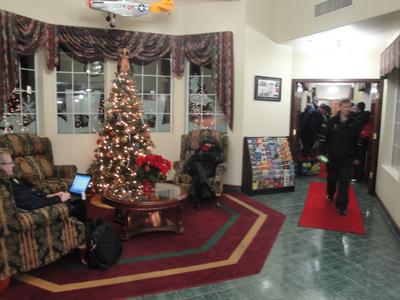
Alan was transported from tent to hotel without missing a keystroke.
Photo: copyright Dale Amon, All Rights Reserved
While Rand went off to see who else was around, I took a few lobby photos and examined the rather interesting hotel trophy case.
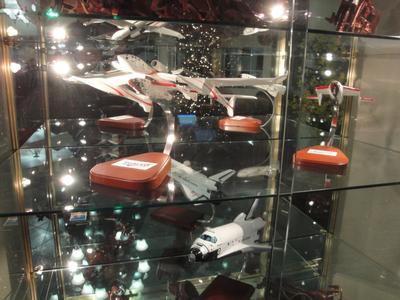
Yep, this is the spaceport hotel…
Photo: copyright Dale Amon, All Rights Reserved
When Rand did not turn up again after a few minutes I went looking and naturally found him with another journalist in the bar. Where else do you find journalists? (Except Alan of course.) They type, they drink and therefore they are.
I must admit my photos went rapidly down hill in quality. By the end of the night the results were about as blurred as what I was actually seeing. Remember, we had free Absolut and wine all day… this was just the after the party party!
It was around this time I heard the evacuation was not just precautionary: the tents had been demolished by the winds.
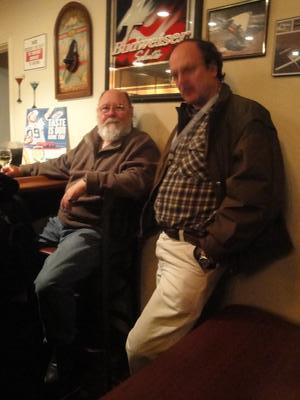
Len David and Rand Simberg at the Spaceport Bar.
Photo: copyright Dale Amon, All Rights Reserved
Pretty much everyone was there, including Burt Rutan and Richard Branson.
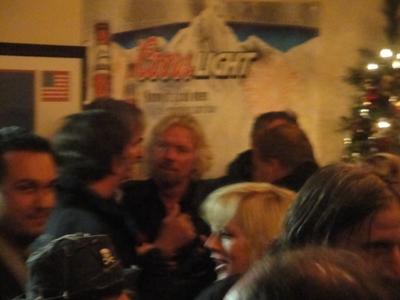
Sir Richard hung out in the Spaceport Bar with a few hundred close friends.
Photo: copyright Dale Amon, All Rights Reserved
Since Mojave is the first official commercial spaceport, I am guessing that makes the Mariah Hotel bar the very first official spaceport bar!
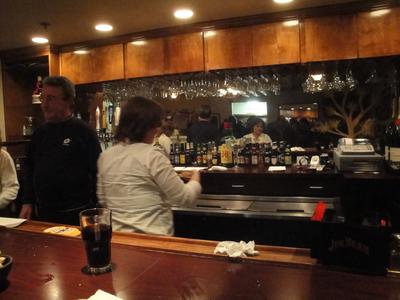
The first spaceport bar.
Photo: copyright Dale Amon, All Rights Reserved
Mostly we stayed in our quiet corner: not too crowded there and the bar staff kept full bottles in our hands. Misuzu Onuki, designer of fashion for space travelers, joined us for awhile. It was impossible to get a candid shot of her as she is just too camera aware! This is not to mention that, by this time, it was surprising I could even find the shutter button…
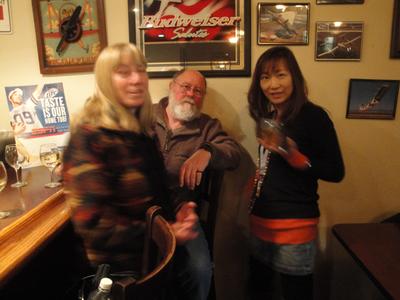
Barb Sprungman, Len David and Misuzu Onuki.
Photo: copyright Dale Amon, All Rights Reserved
Although the party showed little sign of slowing down, we had a long trip ahead of us. Rand pointed me down the hallway towards the front door, but I stopped in the front room to thank Virgin Galactic President Will Whitehorn for a marvelous time. I also noticed Sir Richard was still hanging out and seemed to be enjoying himself thoroughly. He was in a small knot of folk talking in the back of the room.
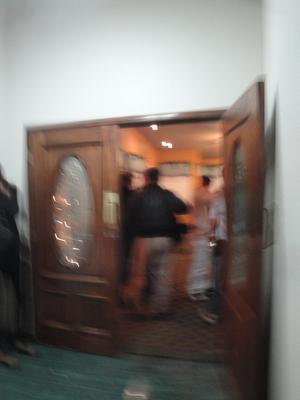
Yep, this is just as I remember seeing it….
Photo: copyright Dale Amon, All Rights Reserved
When we arrived back in LA, I posted my Samizdata teaser story and got into an online chat with one of my friends from the Mojave community. She asked if I felt like helping with the hunt for designer jackets tomorrow morning at the spaceport East fence…
This is the last of a series of 7 articles on the SpaceShipTwo roll out at the Mojave Spaceport. The previous article is here




Dale — mildly off-topic, or maybe just further down the road. If we are going into space, there needs to be someplace to go. NASA launched the Kepler satellite to detect planets revolving around stars. Now NASA has announced the discovery of 5 planets:
“Known as “hot Jupiters” because of their high masses and extreme temperatures, the new exoplanets range in size from similar to Neptune to larger than Jupiter. They have orbits ranging from 3.3 to 4.9 days.”
Something the size of Jupiter wheech-ing around its sun in less than 5 days? Sounds like a test for relativity theory. Is this misprint territory, or “NASA global warming quality” work in space?
Thanks for recording and posting this series, Mr A. Really informative and entertaining reading.
Those planets are nowhere close to relativistic speeds. Not within orders of magnitude. Even if they were, the only problem would be that they were in orbit around a black hole and would probably be losing energy due to gravity ways and spiraling in until it hit a point where tidal forces ripped it apart…
The physics on the NASA results is solid and pretty basic… that does not necessarily mean that someone could have screwed up on one of the data sets, but its rather unlikely.
Dale – thanks for your response. Can you please enlighten me on something?
A book I read on the importance of anomalies to scientific progress used Mercury as an example. Apparently, the motions of Mercury were not consistent with Newtonian mechanics, leading to the hypothesis of the influence of another planet closer to the Sun (which could not be found). In contrast, Einstein’s Theory of Relativity matched the motions of high-speed Mercury precisely — the anomaly overthrew Newton’s theory.
Have I been a victim of misinformation?
Little Mercury’s orbital period is around 90 days — a far cry from something the size of Jupiter screaming around its sun in less than 5 days. These “exoplanets” just sound a little odd. In these post-Climategate days, NASA no longer gets my automatic suspension of doubt.
No, all is right with the world. There are very small relativistic anomalies when ever you have two bodies moving relative to each other. If you take an airplane flight from one point to another you will actually experience a very tiny relativistic time difference. More so with things in orbit. Also, the more intense a gravitation field, the greater the effect. The most famous Einstein experiment had to do with the bending of light around the sun due to the effect of its gravity on the local space time. To do a good job of explaining the very small general relativity explained orbital anomaly of Mercury I’d have to go off and think awhile. You might be better off going to wikipedia as some very smart people have done very good materials on many science topic. Try ‘general relativity’ and ‘Mercury’ in google and see what you come up with.
Again, there are small but measurable effects, just nothing that would seriously effect any normal planet around any normal star.
Dale — thanks for that.
It’s a big universe, but I still gasp at the thought of something the size of Jupiter orbiting a sun in only about 5 days. The planet would have to be so close to the star that there would likely be a significant drag (astronomically speaking) from the star’s solar wind. The planet would be spiralling down to its doom — which makes it unlikely that we would happen to be observing it at the right time. But it is a big universe.
Just can’t stop my spidey sense from tingling about this NASA claim.